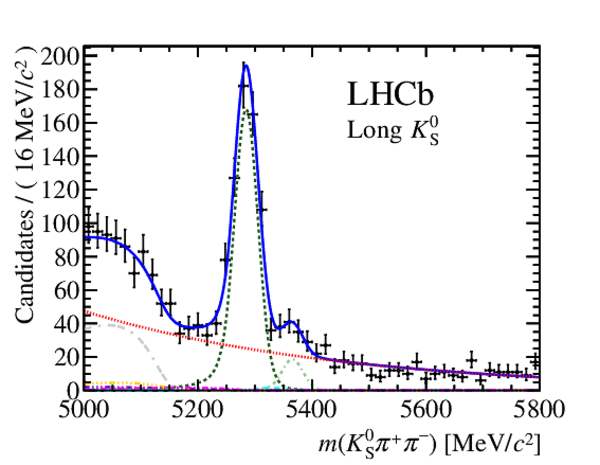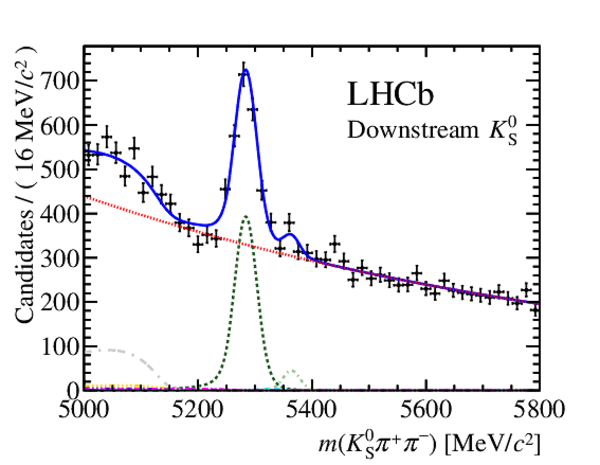Searches for $\Lambda^0_{b}$ and $\Xi^{0}_{b}$ decays to $K^0_{\rm S} p \pi^{-}$ and $K^0_{\rm S}p K^{-}$ final states with first observation of the $\Lambda^0_{b} \rightarrow K^0_{\rm S}p \pi^{-}$ decay
[to restricted-access page]Information
LHCb-PAPER-2013-061
CERN-PH-EP-2014-012
arXiv:1402.0770 [PDF]
(Submitted on 04 Feb 2014)
JHEP 04 (2014) 87
Inspire 1280069
Tools
Abstract
A search for previously unobserved decays of beauty baryons to the final states $K^0_{\rm\scriptscriptstyle S} p \pi^{-}$ and $K^0_{\rm\scriptscriptstyle S}p K^{-}$ is reported. The analysis is based on a data sample corresponding to an integrated luminosity of $1.0 $fb$^{-1}$ of $pp$ collisions. The $\Lambda^0_{b} \rightarrow \overline{ K}^0_{\rm\scriptscriptstyle S}p \pi^{-}$ decay is observed with a significance of $8.6 \sigma$, with branching fraction \begin{eqnarray*} {\cal{B}}(\Lambda^0_{b} \rightarrow \overline{ K}^0 p \pi^{-}) & = & \left(1.26 \pm 0.19 \pm 0.09 \pm 0.34 \pm 0.05 \right) \times 10^{-5} , \end{eqnarray*} where the uncertainties are statistical, systematic, from the ratio of fragmentation fractions $f_{\Lambda}/f_{d}$, and from the branching fraction of the $B^0 \rightarrow K^0_{\rm\scriptscriptstyle S}\pi^{+}\pi^{-}$ normalisation channel, respectively. A first measurement is made of the $CP$ asymmetry, giving \begin{eqnarray*} A_{C/!P} (\Lambda^0_{b} \rightarrow \overline{ K}^0 p \pi^{-}) & = & 0.22 \pm 0.13\mathrm{ (stat)} \pm 0.03\mathrm{ (syst)} . \end{eqnarray*} No significant signals are seen for $\Lambda^0_{b} \rightarrow K^0_{\rm\scriptscriptstyle S}p K^{-}$ decays, $\Xi^{0}_{b}$ decays to both the $K^0_{\rm\scriptscriptstyle S}p \pi^{-}$ and $K^0_{\rm\scriptscriptstyle S}p K^{-}$ final states, and the $\Lambda^0_{b} \rightarrow D^{-}_{s} (\rightarrow K^0_{\rm\scriptscriptstyle S} K^{-}) p$ decay, and upper limits on their branching fractions are reported.
Figures and captions
|
Invariant mass distribution of (top) $ K ^0_{\rm\scriptscriptstyle S} p\pi^{-}$ and (bottom) $ K ^0_{\rm\scriptscriptstyle S} pK^{-}$ candidates for the (left) Downstream and (right) Long $ K ^0_{\rm\scriptscriptstyle S}$ categories after the final selection in the full data sample. Each significant component of the fit model is displayed: $\Lambda ^0_ b $ signal (violet dot-dashed), $\Xi^{0}_{ b } $ signal (green dashed) and combinatorial background (red dotted). The overall fit is given by the solid blue line. Contributions with very small yields are not shown. |
fig1a.pdf [18 KiB] HiDef png [246 KiB] Thumbnail [199 KiB] *.C file |

|
|
fig1b.pdf [19 KiB] HiDef png [255 KiB] Thumbnail [204 KiB] *.C file |

|
|
|
fig1c.pdf [19 KiB] HiDef png [248 KiB] Thumbnail [210 KiB] *.C file |

|
|
|
fig1d.pdf [19 KiB] HiDef png [264 KiB] Thumbnail [215 KiB] *.C file |

|
|
|
Invariant mass distribution of (top) $\Lambda ^0_ b \rightarrow \Lambda ^+_ c (\rightarrow p K ^0_{\rm\scriptscriptstyle S} ) \pi ^- $ , (middle) $\Lambda ^0_ b \rightarrow \Lambda ^+_ c (\rightarrow p K ^0_{\rm\scriptscriptstyle S} ) K ^- $ and (bottom) $\Lambda ^0_ b \rightarrow D ^-_ s (\rightarrow K ^0_{\rm\scriptscriptstyle S} K ^- ) p $ candidates for the (left) Downstream and (right) Long $ K ^0_{\rm\scriptscriptstyle S}$ categories after the final selection in the full data sample. Each significant component of the fit model is displayed: signal PDFs (violet dot-dashed), signal cross-feed contributions (green dashed) and combinatorial background (red dotted). The overall fit is given by the solid blue line. Contributions with very small yields are not shown. |
fig2a.pdf [20 KiB] HiDef png [267 KiB] Thumbnail [201 KiB] *.C file |

|
|
fig2b.pdf [20 KiB] HiDef png [255 KiB] Thumbnail [191 KiB] *.C file |

|
|
|
fig2c.pdf [19 KiB] HiDef png [266 KiB] Thumbnail [208 KiB] *.C file |

|
|
|
fig2d.pdf [19 KiB] HiDef png [236 KiB] Thumbnail [180 KiB] *.C file |

|
|
|
fig2e.pdf [19 KiB] HiDef png [231 KiB] Thumbnail [185 KiB] *.C file |

|
|
|
fig2f.pdf [18 KiB] HiDef png [235 KiB] Thumbnail [186 KiB] *.C file |

|
|
|
Invariant mass distribution of $ K ^0_{\rm\scriptscriptstyle S} \pi^{+}\pi^{-}$ candidates with the selection requirements for the (top) $\Lambda ^0_ b \rightarrow K ^0_{\rm\scriptscriptstyle S} p h ^- $ , (middle) $\Lambda ^0_ b \rightarrow \Lambda ^+_ c (\rightarrow p K ^0_{\rm\scriptscriptstyle S} ) h ^{-}$ and (bottom) $\Lambda ^0_ b \rightarrow D ^-_ s p $ channels separated into (left) Downstream and (right) Long $ K ^0_{\rm\scriptscriptstyle S}$ categories. Each component of the fit model is displayed: the $ B ^0$ ( $ B ^0_ s $ ) decay is represented by the dashed dark (dot dashed light) green line; the background from $ B ^0_ s \rightarrow K ^0_{\rm\scriptscriptstyle S} K ^\pm \pi ^\mp $ decays by the long dashed cyan line; $ B ^- \rightarrow D ^0 (\rightarrow K ^0_{\rm\scriptscriptstyle S} \pi ^+ \pi ^- ) \pi ^- $ (grey double-dash dotted), charmless $ B ^0$ ( $ B ^+ $ ) decays (orange dash quadruple-dotted), $ B ^0 \rightarrow \eta ^{\prime} (\rho^{0} \gamma) K ^0_{\rm\scriptscriptstyle S} $ (magenta dash double-dotted) and $ B ^0 \rightarrow K ^0_{\rm\scriptscriptstyle S} \pi ^+ \pi ^- \gamma$ (dark violet dash triple-dotted) backgrounds; the overall fit is given by the solid blue line; and the combinatorial background by the dotted red line. |
fig3a.pdf [23 KiB] HiDef png [315 KiB] Thumbnail [235 KiB] *.C file |

|
|
fig3b.pdf [23 KiB] HiDef png [299 KiB] Thumbnail [212 KiB] *.C file |

|
|
|
fig3c.pdf [23 KiB] HiDef png [290 KiB] Thumbnail [220 KiB] *.C file |

|
|
|
fig3d.pdf [23 KiB] HiDef png [319 KiB] Thumbnail [240 KiB] *.C file |

|
|
|
fig3e.pdf [23 KiB] HiDef png [290 KiB] Thumbnail [229 KiB] *.C file |

|
|
|
fig3f.pdf [23 KiB] HiDef png [320 KiB] Thumbnail [251 KiB] *.C file |

|
|
|
Background-subtracted, efficiency-corrected Dalitz plot distribution of $\Lambda ^0_ b \rightarrow K ^0_{\rm\scriptscriptstyle S} p \pi ^- $ decays for Downstream and Long $ K ^0_{\rm\scriptscriptstyle S}$ categories combined. Some bins have negative entries (consistent with zero) and appear empty. |
fig4.pdf [30 KiB] HiDef png [108 KiB] Thumbnail [71 KiB] *.C file |

|
|
Animated gif made out of all figures. |
PAPER-2013-061.gif Thumbnail |

|
Tables and captions
|
Fitted yields and efficiency for each channel, separated by $ K ^0_{\rm\scriptscriptstyle S}$ type. Yields are given with both statistical and systematic uncertainties, whereas for the efficiencies only the uncertainties due to the limited Monte Carlo sample sizes are given. The three rows for the $ B ^0 \rightarrow K ^0_{\rm\scriptscriptstyle S} \pi ^+ \pi ^- $ decay correspond to the different BDT selections for charmless signal modes and the channels containing $\Lambda ^+_ c $ or $ D ^-_ s $ hadrons. |
Table_1.pdf [63 KiB] HiDef png [95 KiB] Thumbnail [43 KiB] tex code |

|
|
Relative systematic uncertainties on the branching fraction ratios ($\%$) with respect to $ B ^0 \rightarrow K ^0_{\rm\scriptscriptstyle S} \pi ^+ \pi ^- $ decays. The total is obtained from the sum in quadrature of all contributions except that from knowledge of the fragmentation fractions. |
Table_2.pdf [71 KiB] HiDef png [83 KiB] Thumbnail [39 KiB] tex code |

|
Created on 27 April 2024.
